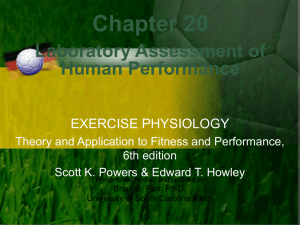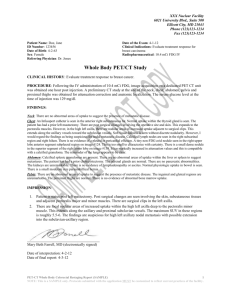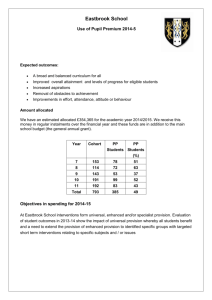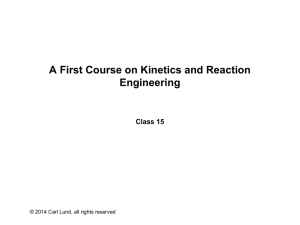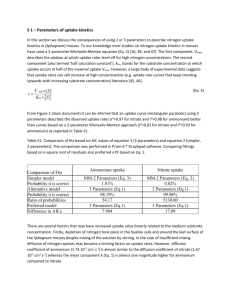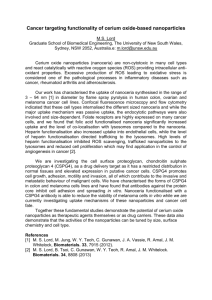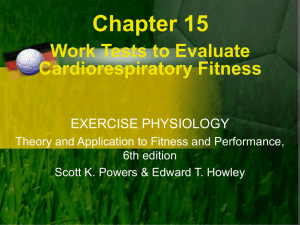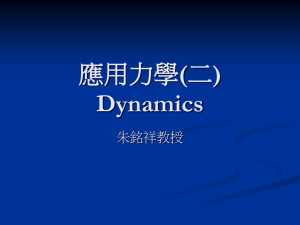Oxygen Uptake Kinetics as a Determinant of Severe
advertisement
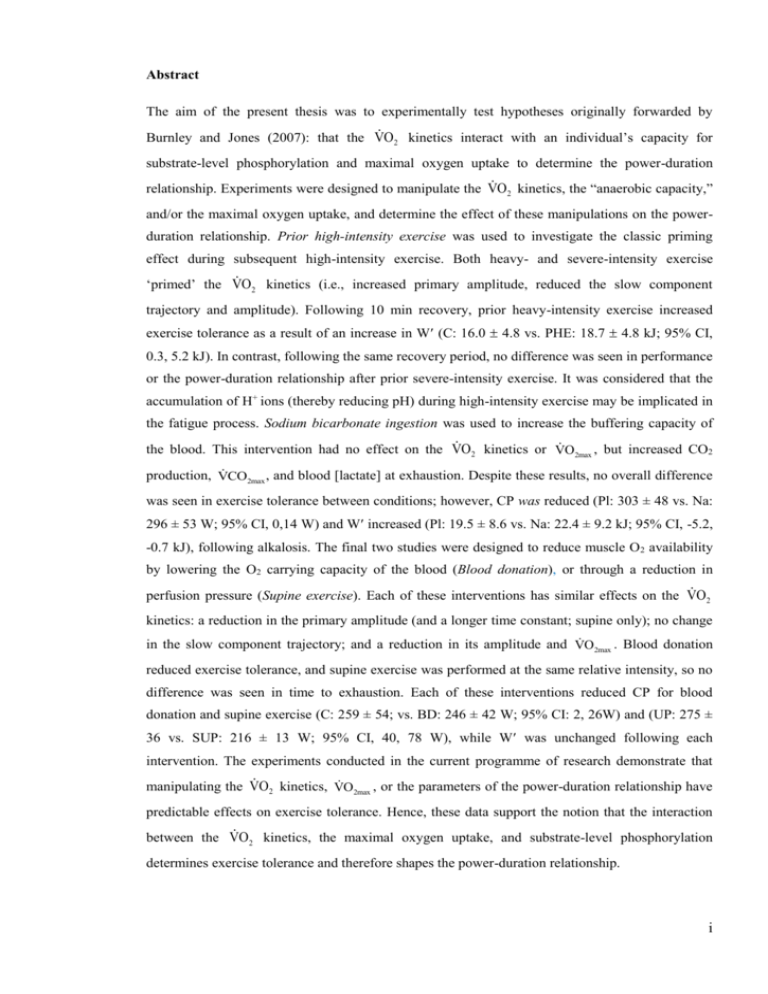
Abstract The aim of the present thesis was to experimentally test hypotheses originally forwarded by Burnley and Jones (2007): that the VO2 kinetics interact with an individual’s capacity for substrate-level phosphorylation and maximal oxygen uptake to determine the power-duration relationship. Experiments were designed to manipulate the VO2 kinetics, the “anaerobic capacity,” and/or the maximal oxygen uptake, and determine the effect of these manipulations on the powerduration relationship. Prior high-intensity exercise was used to investigate the classic priming effect during subsequent high-intensity exercise. Both heavy- and severe-intensity exercise ‘primed’ the VO2 kinetics (i.e., increased primary amplitude, reduced the slow component trajectory and amplitude). Following 10 min recovery, prior heavy-intensity exercise increased exercise tolerance as a result of an increase in W (C: 16.0 4.8 vs. PHE: 18.7 4.8 kJ; 95% CI, 0.3, 5.2 kJ). In contrast, following the same recovery period, no difference was seen in performance or the power-duration relationship after prior severe-intensity exercise. It was considered that the accumulation of H+ ions (thereby reducing pH) during high-intensity exercise may be implicated in the fatigue process. Sodium bicarbonate ingestion was used to increase the buffering capacity of the blood. This intervention had no effect on the VO2 kinetics or VO2max , but increased CO2 production, VCO2max , and blood [lactate] at exhaustion. Despite these results, no overall difference was seen in exercise tolerance between conditions; however, CP was reduced (Pl: 303 ± 48 vs. Na: 296 ± 53 W; 95% CI, 0,14 W) and W increased (Pl: 19.5 ± 8.6 vs. Na: 22.4 ± 9.2 kJ; 95% CI, -5.2, -0.7 kJ), following alkalosis. The final two studies were designed to reduce muscle O 2 availability by lowering the O2 carrying capacity of the blood (Blood donation), or through a reduction in perfusion pressure (Supine exercise). Each of these interventions has similar effects on the VO2 kinetics: a reduction in the primary amplitude (and a longer time constant; supine only); no change in the slow component trajectory; and a reduction in its amplitude and VO2max . Blood donation reduced exercise tolerance, and supine exercise was performed at the same relative intensity, so no difference was seen in time to exhaustion. Each of these interventions reduced CP for blood donation and supine exercise (C: 259 ± 54; vs. BD: 246 ± 42 W; 95% CI: 2, 26W) and (UP: 275 ± 36 vs. SUP: 216 ± 13 W; 95% CI, 40, 78 W), while W was unchanged following each intervention. The experiments conducted in the current programme of research demonstrate that manipulating the VO2 kinetics, VO2max , or the parameters of the power-duration relationship have predictable effects on exercise tolerance. Hence, these data support the notion that the interaction between the VO2 kinetics, the maximal oxygen uptake, and substrate-level phosphorylation determines exercise tolerance and therefore shapes the power-duration relationship. i Table of Contents Page Abstract Table of contents List of tables List of figures Symbols, abbreviations and definitions Declaration and statements Communications and publications Acknowledgements i ii vi vi vii xi xii xiii Introduction and review of literature Chapter 1 Introduction Endurance performance is a question of speed and time Energy, oxygen and muscular work Chapter 2 2 3 Review of literature 2.1 - Parameters of the physiological response to exercise Maximum oxygen uptake Lactate threshold / gas exchange threshold Exercise economy / efficiency Anaerobic capacity 2.2 - Oxygen uptake response to exercise Oxygen uptake response at exercise onset - the oxygen deficit Technological advances and the development of more complex oxygen uptake models Phase I - the 'cardiodynamic' component Phase II - the 'primary' component Control of cellular respiration at exercise onset Pulmonary vs. muscle oxygen uptake Phase III - the 'steady-state' or the 'slow component' Mechanisms for the oxygen uptake slow component Muscle temperature, acid-base status and blood [lactate] Motor unit recruitment and muscle fibre energetics Characteristics of the oxygen uptake response across the exercise intensity spectrum Exercise below the lactate/gas exchange threshold The moderate intensity domain Exercise above the lactate/gas exchange threshold - 'high' intensity exercise The heavy intensity domain The severe intensity domain Exercise above the maximum oxygen uptake The 'extreme' intensity domain 7 7 8 9 10 12 12 14 15 16 17 19 20 21 23 23 25 25 25 26 26 26 27 27 ii 2.3 - The power duration relationship Historical perspectives Mathematical modelling of the power-duration relationship Two-parameter models Key assumptions and considerations of modelling the power-duration relationship Three-parameter models Model selection considerations Protocol design and implementation considerations Determination of time to exhaustion and the influence of practice Duration of trials Number of trials and recovery time between trials Cadence The physiological response to exercise above and below critical power Physiological determinants of W' 2.4 - Mechanisms of fatigue Determinants of endurance performance - traditional perspectives Determinants of endurance performance - a contemporary viewpoint Interaction between the oxygen uptake kinetics and the power-duration relationship 2.5 - Intervention to test the link between the oxygen uptake kinetics and the power-duration relationship 3.3 29 31 31 32 33 35 36 36 37 38 39 40 41 46 46 47 48 50 Muscle metabolism High-energy phosphate stores Metabolite accumulation Acid-base status Muscle oxygen availability Inspired oxygen fraction Oxygen transport in the blood Perfusion pressure Conclusion 50 50 51 52 53 54 54 56 57 Aims and hypotheses 58 Chapter 3 3.1 3.2 29 General Methods Health and safety Participant recruitment, preparation and care Familiarisation, feedback and test termination procedures Measurement procedures Descriptive data Cycle ergometers Pulmonary gas exchange Incremental test to determine the gas exchange threshold and the maximal oxygen uptake Pulmonary gas exchange during square-wave exercise Determination of the power-duration relationship Heart rate 60 60 61 62 62 62 62 63 64 65 66 iii 3.4 Haematology General preparation Determination of whole blood haematology Determination of acid-base status Determination of blood [lactate] Statistical analysis 66 66 67 67 68 68 Experimental chapters Chapter 4 4.1 4.2 4.3 4.4 Introduction Aims and Hypothesis Methods Experimental design and protocols Results Incremental exercise and the 'control' condition power-duration relationship Heavy priming Severe Priming Discussion Heavy priming Severe priming Recovery duration The oxygen uptake slow component and exercise tolerance Limitations Conclusion Chapter 5 5.1 5.2 5.3 5.4 70 72 72 72 73 73 73 74 78 78 79 80 80 81 82 Sodium bicarbonate and the power-duration relationship Introduction Aims and Hypothesis Methods Experimental design and protocols Results Incremental exercise Acid-base status Oxygen uptake kinetics Carbon dioxide kinetics Blood [lactate] and heart rate Exercise tolerance and the power-duration relationship Discussion Acid base status Oxygen uptake kinetics Exercise tolerance Power-duration relationship Conclusion Chapter 6 6.1 The effect of priming exercise on the power-duration relationship 83 84 85 85 86 86 86 86 87 90 91 92 92 93 95 97 99 Blood donation and the power-duration relationship Introduction Aims and Hypothesis 100 100 iv 6.2 6.3 6.4 Methods Experimental design and protocols Results Incremental exercise Oxygen uptake kinetics Blood [lactate] and heart rate Exercise tolerance and the power-duration relationship Discussion Haematology Oxygen uptake kinetics Exercise tolerance and the power-duration relationship Conclusion Chapter 7 7.1 7.2 7.3 7.4 101 101 102 102 102 103 103 105 105 106 108 109 Supine exercise and the power-duration relationship Introduction Aims and Hypothesis Methods Experimental design and protocols Results Incremental exercise Oxygen uptake kinetics Blood [lactate] and heart rate Exercise tolerance and the power-duration relationship Discussion Incremental exercise Justification for using relative exercise intensities Oxygen uptake kinetics Power-duration relationship Conclusion 111 112 113 113 114 114 114 115 118 118 119 119 120 122 123 General discussion Chapter 8 General discussion Summary of the main themes investigated in this thesis Summary of the oxygen uptake response to severe-intensity exercise Summary of the power-duration relationship Limitations of this thesis - methodological considerations Summary of the main experimental observations Study 1 - Priming exercise and the power-duration relationship Study 2 - Sodium bicarbonate and the power-duration relationship Study 3 - Blood donation and the power-duration relationship Study 4 - Supine exercise and the power-duration relationship Main research findings Determinants of the capacity to perform work above CP Future directions Final conclusions References 125 126 126 127 129 129 130 130 131 131 132 134 135 137 v List of Tables Page 4.1 4.2 5.1 5.2 5.3 6.1 6.2 7.1 7.2 Power-duration relationship following priming exercise Oxygen uptake kinetics and exercise tolerance following priming exercise Oxygen uptake kinetics following sodium bicarbonate ingestion Carbon dioxide kinetics following sodium bicarbonate ingestion Blood [lactate], heart rate and time to exhaustion following sodium bicarbonate ingestion Haematological parameters following blood donation Oxygen uptake kinetics following blood donation Oxygen uptake kinetics during supine exercise Blood [lactate], heart rate and time to exhaustion during supine exercise 75 76 87 88 90 102 104 116 117 List of Figures Page 1.1 The relationship between average speed and finishing time during World record efforts in running and swimming 3.1 Determination of the gas exchange threshold 4.1 Oxygen uptake responses and power-duration relationships following priming exercise 5.1 Pulmonary gas exchange response following sodium bicarbonate ingestion 5.2 Power-duration relationship following sodium bicarbonate ingestion 6.1 Power-duration relationship 7.1 Oxygen uptake responses following supine exercise 3 64 77 89 91 105 118 vi Symbols, Abbreviations and Definitions [] concentration (mM) 31 P phosphorus 31 P-MRS 31 A P nuclear magnetic resonance spectroscopy asymptotic amplitude of a mathematically modelled response for example, of the increase in VO 2 above baseline a-vO2 diff arteriovenous oxygen difference (mLO2∙100mL-1 of whole blood) a measure of O2 extraction from the blood ADP adenosine 5' -diphosphate APVE acute plasma volume expansion ATP adenosine 5' -triphosphate ATPase enzyme that catalyses the decomposition of ATP into ADP BD blood donation BL baseline Ca 2+ calcium C6H10O5 microcrystaline cellulose C control Cr creatine CK creatine kinase CO2 carbon dioxide CP critical power (W) asymptote of the hyperbolic relationship between power output and time to exhaustion CV critical velocity (m·min-1) determined from the hyperbolic relationship between velocity and time to exhaustion CWR constant work rate ∆ delta; a difference or a change in value %Δ percentage delta the difference between the VO 2 at the GET and VO2max e exponential term (2.71828) ECG electrocardiogram EDTA ethylenediaminetetraacetate EMG electromyogram (mV) GET gas exchange threshold G change in VO2 per unit change in external work (i.e. VO 2 /ΔWR; mL∙min-1∙W-1) H+ hydrogen ion Hb haemoglobin (g∙dl-1) HbO2 oxyhaemoglobin Hct haematocrit (%) HCO3- bicarbonate HHb deoxyhaemoglobin vii HR heart rate (b·min-1) HRmax maximum heart rate (b·min-1) H2O water iEMG intergrated electromyogram (mV∙s-1) Intensity work rate characterised by a distinct gas exchange response profile IU international units kt rate constant K + potassium L-Name L-nitro arginine methyl ester (inhibits nitric oxide synthase) LBF leg blood flow LT lactate threshold exercise intensity which elicits a sustained increase in blood [lactate] above resting values Mb myoglobin mVO2 muscle oxygen utilisation (L∙min-1; mL∙min-1) rate at which mitochondria consume oxygen in aerobic ATP resynthesis MAOD maximal accumulated oxygen deficit (L) MBF muscle blood flow MCV mean cell volume (µm3) MLSS maximal lactate steady state the highest VO 2 at which blood lactate can be stabilised MSS maximal steady state highest exercise intensity that elicits stable VO 2 , blood lactate, pH etc over time MRS magnetic resonance spectroscopy MRT mean response time (s) time taken to reach 63% of the VO 2 response, thereby estimating the overall 'speed' of the VO 2 kinetics MSS maximal steady state n number (e.g. of participants) Na + sodium NaCl sodium chloride (salt) NaHCO3 sodium bicarbonate NIRS near infra-red spectroscopy NO nitric oxide O2 oxygen O2 deficit difference between energy requirement of a work rate and that supplied through oxidative metabolism pH a logarithmic scale used to express the acidity or alkalinity of a solution pVO2 P pulmonary oxygen uptake (L∙min-1; mL∙min-1) PCr phosphocreatine power output (W) viii PCO2 partial pressure of carbon dioxide (mmHg) PFK phosphofructokinase PHE prior heavy exercise Pl placebo PSE prior severe exercise Pi inorganic phosphate PO2 partial pressure of oxygen (mmHg) Phase I phase I of the VO2 kinetics the 'cardiodynamic' component of the VO 2 kinetics following a step change in work-rate Phase II phase II of the VO2 kinetics the 'primary' phase of the VO 2 kinetics, the exponential increase in VO 2 following a step change in work-rate Phase III phase III of the VO2 kinetics the attainment of a steady-state in VO 2 following a step-increase in work-rate P-t power-time relationship Q cardiac output (L∙min-1) product of HR and stroke volume per unit of time rpm revolutions per min used to define pedal cadence during cycle ergometry RhEPO recombinant human erythropoietin RBC red blood cell count (106·mm3) RDW red cell distribution width (subscript) 'p' signifies 'primary', for example the primary VO2 response (subscript) 's' signifies 'slow', for example the slow component of the VO2 response SD standard deviation SEE standard error of estimate SLP substrate level phosphorylation ATP re-synthesis via non-O2-dependent pathways SUP supine exercise SV stroke volume t time (s) t1/2 half-time time point at with 50% of the change in VO 2 from baseline to the end of exercise occurs TD time delay Tlim time to exhaustion (s) Tau (τ) phase II VO2 time constant (s) time taken to achieve 63% of the asymptotic amplitude in an exponential function UP upright exercise ix VCO2 carbon dioxide output (L∙min-1; mL∙min-1) volume of carbon dioxide expired per unit of time VE expired minute ventilation (L∙min-1) volume of air expired in one minute VE / VCO2 ventilatory equivalent for CO2 VE / VO2 ventilatory equivalent for O2 VCO2max maximal carbon dioxide output (L∙min-1; mL∙min-1) maximal carbon oxygen output per unit of time VO 2 pulmonary oxygen uptake (L∙min-1; mL∙min-1) volume of oxygen extracted and utilised from the inspired gas per unit of time VO2max maximal oxygen uptake (L∙min-1; mL∙min-1) maximal oxygen uptake per unit of time VO2peak peak oxygen uptake (L∙min-1; mL∙min-1) peak oxygen uptake per unit of time VO 2 SC oxygen uptake 'slow-component' the increase in VO 2 above phase II of the VO 2 response seen during exercise above the LT/GET - with an amplitude (mL.min-1) and a trajectory towards VO2max (L.min-2) VO 2 /WR oxygen uptake to work rate relationship (mL∙min-1∙W-1) typically used to describe exercise economy VT ventilatory threshold W watts unit of power, i.e., work done per unit time W' curvature constant of the power-duration relationship (J; kJ) WR work rate (W) WRpeak work rate peak (W) W-t work-time relationship x Declaration and statements Declaration This work has not previously been accepted in substance for any degree and is not concurrently submitted in candidature for any degree. Signed…………………………………… (candidate) Date……………………………………… Statement 1 This thesis is the result of my own investigations, except where otherwise stated. Where correction services have been used, the extent and nature of the corrections is clearly marked in the footnote(s). Other sources are acknowledged by footnotes giving explicit references. A bibliography is appended. Signed…………………………………… (candidate) Date……………………………………… Statement 2 I hereby give consent for my thesis, if accepted, to be available for photocopying and for interlibrary loan, and for the title and summary to be made available to outside organisations. Signed…………………………………… (candidate) Date……………………………………… xi Communications and publications The following communications and publications are a direct consequence of this work: Communications: Baker, J.R., Davison, G. and Burnley, M. (2008). Oxygen uptake kinetics as a determinant of severe-intensity exercise tolerance. BASES, Bedfordshire. Baker, J.R., Davison, G. and Burnley, M. (2010). The effect of blood donation on the VO2 and the power-duration relationship. BASES, Glasgow. Publications: Burnley, M., Davison, G. and Baker, J.R. (2011). Effects of heavy and severe priming exercise on VO2 kinetics and the power-duration relationship. Medicine and Science in Sports and Exercise, 43, 2171-2179. xii Acknowledgements This work was supported by a full-time research scholarship from department of Sport and Exercise Science at the University of Wales, Aberystwyth. As such, I am grateful to the University and both the staff and students of department for supporting my studies over the past seven years – it has been quite a journey! Professor Jo Doust provided my first glimpse into the wonders of academia, he taught me the value of logical thinking and his teachings gave the confidence to question the available evidence and to formulate my own conclusions, for this I am very grateful. I would also like to thank Professor John Barrett for providing the opportunity to pursue my postgraduate research, and to Professor David Lavallee and Dr Joanne Thatcher for their continued support throughout this period. I have had the privilege to work under an exceptional supervisor in Dr Mark Burnley. He truly is a leader in the field of oxygen uptake kinetics and his tutorage has been fundamental in my understanding of this complex topic – furthermore, providing the freedom to find my own path has pivotal to my development as an independent researcher. I am similarly grateful to Dr Glen Davison for his time and attention, for providing the alternative viewpoint, and highlighting the bigger picture where required. I have had the pleasure to work alongside some fantastic postgraduate students, the experiences I have had over the past four years are something that I will never forget. Special thanks go to Dr Simon Payne and Stuart Flint for providing humour and hindrance in equal measure – without you guys I would have completed some time ago, but I wouldn’t have had so much fun. Of course, I am also indebted to the poor individuals who agreed to take part in my studies, and especially to those who came back time and again – who in their right mind would want to put themselves through so much suffering? I am forever indebted to both my friends and family for providing continued support throughout my life, without you all I would not be where I am today. And finally, to Rosamund, thank you for your understanding, patience and most of all, for your encouragement over the past two years. Jonathan Baker th 17 September 2011 xiii

